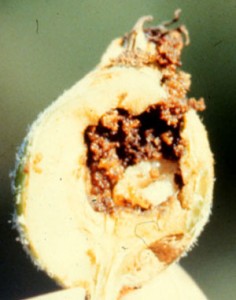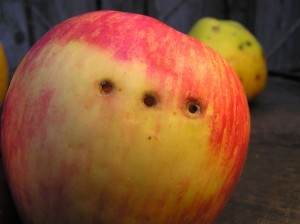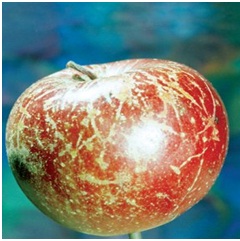Apples are easy to grow, productive, and there are shapes and sizes for every  garden. They can be susceptible to a range of pests, diseases and disorders, but in most cases action can be taken to prevent or control the problem. It is a melancholy fact that the apple is attacked by a wide range of pests and diseases which at worst can reduce the crop to zero, and damage or even kill the tree. We learned this the hard way. It’s true that you can get some sort of crop by leaving nature to itself, but for consistent quality, and some years to get even one clean apple, you need to understand and outwit the little beasties and bugs. Apple sawfly is one among the many perpetrators of apple damage.
garden. They can be susceptible to a range of pests, diseases and disorders, but in most cases action can be taken to prevent or control the problem. It is a melancholy fact that the apple is attacked by a wide range of pests and diseases which at worst can reduce the crop to zero, and damage or even kill the tree. We learned this the hard way. It’s true that you can get some sort of crop by leaving nature to itself, but for consistent quality, and some years to get even one clean apple, you need to understand and outwit the little beasties and bugs. Apple sawfly is one among the many perpetrators of apple damage.
 Adult apple sawflies are small insects with blackish brown heads and thorax and brown abdomens. The caterpillar-like larvae initially tunnel beneath the skin of the developing apples, causing a scarring and then further damage.
Adult apple sawflies are small insects with blackish brown heads and thorax and brown abdomens. The caterpillar-like larvae initially tunnel beneath the skin of the developing apples, causing a scarring and then further damage.
When apple trees are in flower, the sawfly, Hoplocampa testudinea, lays its eggs in the developing fruit. In June, the larvae tunnel their way under the skin of the fruit and into the core, causing the  apples to fall. When they’re ready, they tunnel out of the apples, creating a second hole, and then bury themselves in the soil to pupate. Sometimes the larvae die and don’t make it to the middle of the apple, in which case the apples mature, but they’ll have ribbon scars and are sometimes misshapen.
apples to fall. When they’re ready, they tunnel out of the apples, creating a second hole, and then bury themselves in the soil to pupate. Sometimes the larvae die and don’t make it to the middle of the apple, in which case the apples mature, but they’ll have ribbon scars and are sometimes misshapen.
European Apple sawfly overwinters as a mature larva in a cocoon a few centimeters below the soil surface. The larva pupates in the spring and adults emerge during the pink stage of apples. The female European apple sawfly lays eggs just after the king flower opens. Each female lays about 30  eggs singly in the opening flowers. Eggs are deposited singly at the calyx end of the flower, often at the base of or between the stamens. Sap seeps out of the wound made by the female when laying her eggs. It turns red/brown and can be a good early warning of an attack. A larva hatches after two weeks, newly hatched larva burrow into the apple and feed on tissue just below the skin. As the larva matures, it tunnels deeper into the seed cavity and feeds on one or two seeds. Once under the skin of the fruitlet it tunnels in the surface layer before it burrows into the core. If it does not reach the core it still causes superficial damage which results in the characteristic curved scars. It tunnels out an area of the fruit, filling it with wet brown droppings or frass. Larvae may move on and attack two or three apples, and sometimes more than one grub is found in a single fruit. Often the fruitlets attacked later have masses of frass at the eye where the entry hole was made. After two weeks’ feeding, the larvae leave the fruit to overwinter in the soil. There is one generation per year. Diapause stage may last for up to three years.
eggs singly in the opening flowers. Eggs are deposited singly at the calyx end of the flower, often at the base of or between the stamens. Sap seeps out of the wound made by the female when laying her eggs. It turns red/brown and can be a good early warning of an attack. A larva hatches after two weeks, newly hatched larva burrow into the apple and feed on tissue just below the skin. As the larva matures, it tunnels deeper into the seed cavity and feeds on one or two seeds. Once under the skin of the fruitlet it tunnels in the surface layer before it burrows into the core. If it does not reach the core it still causes superficial damage which results in the characteristic curved scars. It tunnels out an area of the fruit, filling it with wet brown droppings or frass. Larvae may move on and attack two or three apples, and sometimes more than one grub is found in a single fruit. Often the fruitlets attacked later have masses of frass at the eye where the entry hole was made. After two weeks’ feeding, the larvae leave the fruit to overwinter in the soil. There is one generation per year. Diapause stage may last for up to three years.
First instar larvae feed beneath the fruit skin and create a heavily russeted,  winding, ribbon-like scar that spirals out from the calyx end. If larva ceases feeding at this early stage, for whatever reason, this damage will likely be seen on mature fruit at harvest. If this tunneling stops early, tunneling scars are short and indistinguishable from damage caused by the tarnished plant bug. Second instar larvae tunnel into fruit towards the seed cavity. Reddish-brown frass is often seen protruding from an exit hole in fruit (Figure 4-60). Larval feeding into the core of the apple often causes fruit to abort, while sub-surface feeding creates scars visible on the fruit at harvest.
winding, ribbon-like scar that spirals out from the calyx end. If larva ceases feeding at this early stage, for whatever reason, this damage will likely be seen on mature fruit at harvest. If this tunneling stops early, tunneling scars are short and indistinguishable from damage caused by the tarnished plant bug. Second instar larvae tunnel into fruit towards the seed cavity. Reddish-brown frass is often seen protruding from an exit hole in fruit (Figure 4-60). Larval feeding into the core of the apple often causes fruit to abort, while sub-surface feeding creates scars visible on the fruit at harvest.
As the larva molts and matures, it moves towards the seed cavity or adjacent fruit. As the larva feeds internally, it enlarges its exit hole with wet, reddish- brown frass on the side of the fruit. The larva moves to other fruit in the cluster to continue feeding. A single larva can damage several apples. Damaged fruit drops during the “June drop” period. Fruitlets that suffered only initial feeding damage by a larva will stay on the tree and develop as fruits. These fruits are misshapen and have a long ribbon-like scar about 4mm wide, often starting at the eye end of the fruit and extending around the circumference.
brown frass on the side of the fruit. The larva moves to other fruit in the cluster to continue feeding. A single larva can damage several apples. Damaged fruit drops during the “June drop” period. Fruitlets that suffered only initial feeding damage by a larva will stay on the tree and develop as fruits. These fruits are misshapen and have a long ribbon-like scar about 4mm wide, often starting at the eye end of the fruit and extending around the circumference.
The European apple sawfly is an introduced pest that was first noted in North America infesting crabapples on Long Island and Vancouver Island during 1939 and 1940, respectively. Since then it has spread into southern New Jersey, Vermont, New Hampshire, and the Southern Tier of New York State. The pest is especially troublesome in the apple-growing regions of Massachusetts, Connecticut, Rhode Island, and the Hudson Valley of New York. In the Pacific Northwest, the European apple sawfly appears to be limited to Vancouver Island. The pest is distributed over the entire continent of Europe but is most common in the north. It is found throughout England but is abundant only in certain localities. The larvae feed on all apple and crabapple varieties but show a preference for early or long-blooming varieties with a heavy set of fruit. Sawflies are primitive hymenopterous insects and are related to bees, wasps, and ants. Although two generations a year have been reported in England, only one seems to occur in populations in North America.
The apple sawfly now occurs in almost all the apple orchards. In 1988, it cause near about 14% of damage in the commercial apple orchard in Quebec.
Let’s take a look at the following article which shows how apple sawflies are a nuisance;
Battling European sawfly and powdery mildew
By Dan Woolley | Apr 2011
Nova Scotia Fruit Growers’ Association (NSFGA) members recently received some expert advice on how to deal with two increasingly prevalent problems in Annapolis Valley orchards – European sawfly and powdery mildew
European sawfly
 Erika Bent, who operates Agricultural Pest Monitoring, told attendees of the recent NSFGA annual meeting the European sawfly was only an occasional problem in Nova Scotia until 2005 and 2006. By the 2008 harvest, fruit injury level ranged from zero to six per cent. Six per cent is “quite high” for one insect, said Bent.
Erika Bent, who operates Agricultural Pest Monitoring, told attendees of the recent NSFGA annual meeting the European sawfly was only an occasional problem in Nova Scotia until 2005 and 2006. By the 2008 harvest, fruit injury level ranged from zero to six per cent. Six per cent is “quite high” for one insect, said Bent.
Sawfly larvae overwinter in the soil, pupate in the spring and emerge as adult flies just before the apple trees bloom to lay their eggs in apple buds and blossoms, Bent explained, adding it takes eight to 10 days for the sawfly’s eggs to hatch. Within four weeks, they are fully grown larvae feeding on the fruitlets.
Growers can reduce sawfly damage by applying insecticide when the larvae are moving from fruitlet to fruitlet, said Bent, who during trapping research in 2007 began capturing adult sawflies about May 22 and spotted their first eggs by June 5. She recommends spraying for sawfly at the time apple blooms are opening.
Control is difficult, Bent admits, as growers cannot spray for the adult sawfly during bloom. Instead, she suggests spraying as close as possible to the bloom to reduce the adult insects, then spraying again after the bloom to stop the larvae from moving between the developing fruit.
Currently, there are two insecticides registered for sawfly in Canada, Bent explained, and one of them – Guthion – is being phased out, leaving Assail as the only control for sawfly.
Quebec and Ontario are introducing a predatory parasite for European sawfly, but it is not a stand-alone control, she said.
The saying goes, “An Apple a day keeps the doctor away”. But now the case has become that the apple themselves need a doctor to keep them safe from vicious pests like apple sawfly. Conventionally people use two methods to fight this problem. One is to physically remove the tainted apples from the orchards so that the other apples do not get infected. Following this method is very tiring and is not at an efficient method to protect the apples from pests. The other method is using toxic and hazardous insecticides. Use of insecticides is harmful as these chemicals generally find their way in the food chain and harm living beings.
Hence to help alleviate or else completely eradicate the infestation we C Tech Corporation provide you with the best effective solution Combirepel™. Combirepel™ is an anti-insect aversive developed on the grounds of green chemistry and technology.
Our product works on the mechanism of repellency. It temporarily inhibits the mating cycle of the insects. The product impairs the ability of the insects to reproduce, that is the insects will not lay eggs or the laid eggs will be infertile. The product causes feeding disruption in an insect by triggering an unpleasant reaction within the insect which might try to feed on the application. The product temporarily blocks the reproduction system of the insects by hindering the release of the vital hormones for growth.
Combirepel™ is thermally stable and does not degrade on exposure to heat and sunlight. It does not kill or harm the insect but repels them. It does not volatilize and does not degrade the soil. It is RoHS, RoHS2, ISO, REACH, APVMA, NEA compliant and FIFRA exempted.
Combirepel™ is an eco-friendly product which acts as an aversive to repel the pesky insects like roaches. Combirepel™ do not kill the targeted as well as non-targeted species but just repel them causing no harm no to human and environment.
Combirepel™ is available in the form of masterbatch, liquid concentrate, and lacquer. Our Combirepel™ masterbatch can be used in polymer base applications like wires, cables, irrigation pipes, polymeric vessels, and other various applications.
Combirepel™ liquid concentrate can be mixed in the paints to cover the areas like cracks and crevices of walls and hidden places where the roaches tend to survive.
Combirepel™ lacquer is the topical coating to cover the places like bathrooms, cupboards, steam tunnels, etc.
Hence we provide you with the best effective solution.
Contact us as technical.marketing@ctechcorporation.com to get solution on pest nuisance.
Also, visit our websites:
http://www.ctechcorporation.com/
http://www.rodrepel.com/
http://www.termirepel.com/
http://www.combirepel.com/
Follow our Facebook pages at:
1] https://www.facebook.com/Combirepel-411710912249274/
2] https://www.facebook.com/Termirepel-104225413091251/
3] https://www.facebook.com/Rodrepel-120734974768048/
Follow us on our Twitter pages at:
1] https://twitter.com/rodrepel
2] https://twitter.com/termirepel
3] https://twitter.com/combirepel

